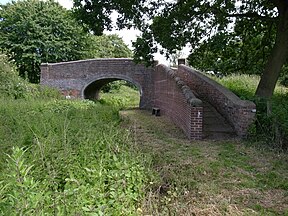Hatherton Canal
| Hatherton Canal | |
|---|---|

Accommodation bridge accessed from the Roman Way Hotel, at eastern limit of public access
|
|
| Specifications | |
| Locks | 21 |
| Status | part extant |
| History | |
| Date of first use | 1841 |
| Date completed | 1863 |
| Date closed | 1949 |
| Geography | |
| Start point | Calf Heath |
| End point | Churchbridge |
| Connects to | Staffordshire and Worcestershire Canal, Cannock Extension Canal |
The Hatherton Canal is a derelict branch of the Staffordshire and Worcestershire Canal in south Staffordshire, England. It was constructed in two phases, the first section opening in 1841 and connecting the main line to Churchbridge, from where a tramway connected to the Great Wyrley coal mines. The second section was a joint venture with the Birmingham Canal Navigations, and linked Churchbridge to the Cannock Extension Canal by a flight of 13 locks, which were opened with the Extension Canal in 1863. The coal traffic was very profitable, and the canal remained in use until 1949. It was formally abandoned in 1955, after which the Churchbridge flight and much of the Extension Canal were destroyed by open cast mining.
Plans for its restoration began in 1975 and the forerunner to the Lichfield and Hatherton Canals Restoration Trust was formed in 1989. Since then they have worked hard to protect and restore the canal, which was threatened by the route of the M6 Toll motorway. Negotiations eventually led to the provision of two culverts, one paid for by the Trust and the other by the road builders, which will be used in due course for the route of the re-aligned canal. In 2006, the engineers Arup produced a feasibility study for a replacement route for the destroyed section which would link to Grove Basin on the Cannock Extension Canal. Environmental concerns led to a second feasibility study being produced by Atkins in 2009, for a route which connected to the derelict Lord Hayes Branch on the Wyrley and Essington Canal. A short section near the junction with the Staffordshire and Worcestershire Canal is navigable, and the cost of restoring the rest and building the new route to the Wyrley and Essington was estimated at £44.1 million in 2009.
The Hatherton Canal was built in two phases by two separate canal companies, over a period of some 20 years. The first part to be constructed ran from Hatherton Junction at Calf Heath on the Staffordshire and Worcestershire Canal to Churchbridge, and was built as a branch of the main canal by the Staffordshire and Worcestershire Canal Company. There had been proposals for a tramway following a similar route in 1798, to link to collieries owned by a Mr. Vernon near Wyrley. Plans for the tramway were borrowed by the canal company, and formed the basis for surveys in 1826 and 1830, but the branch as built followed a somewhat different route, and was surveyed in 1837. Unusually, an Act of Parliament was not obtained for the work, and so all land required for the project had to be bought by agreement with the landowners. Negotiations were completed by 4 April 1839, at which point the company accepted an estimate of £12,345 from Robert Frost, and construction began. This phase was completed in April 1841, and a tramway from the terminus to Great Wyrley, which was used to transport coal, was completed the following year. Both the canal and the tramway were financed out of income, as the canal company was very profitable at the time, paying dividends to shareholders which had exceeded 25 per cent for over thirty years. The branch was called the Hatherton Branch after the company chairman, Lord Hatherton.
...
Wikipedia
